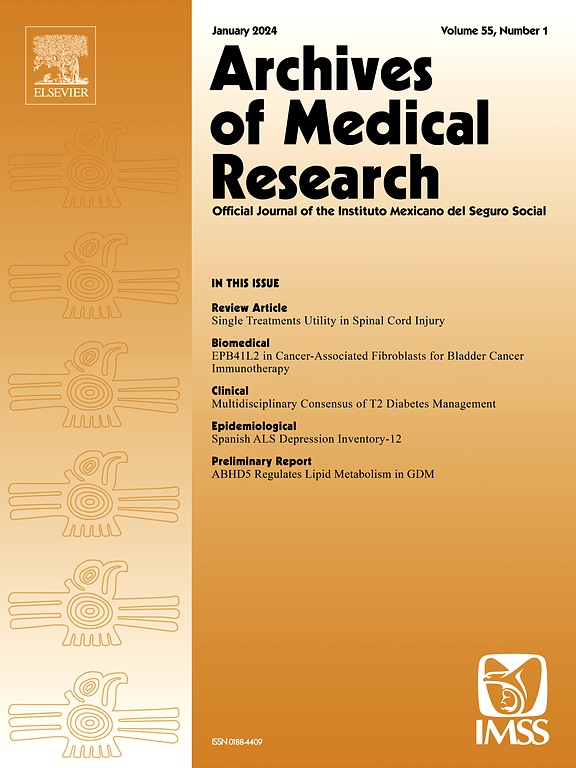信号蛋白7A通过itg - β1/NF-κB通路诱导肝脏炎症和促进肠外营养相关性胆汁淤积
IF 3.4
3区 医学
Q1 MEDICINE, RESEARCH & EXPERIMENTAL
引用次数: 0
摘要
目的探讨信号蛋白7A (Sema7A)在新生儿肠外营养相关性胆汁淤积症(PNAC)中的作用机制。方法首先,我们测量了Sema7A和炎症因子在PNAC新生儿和大鼠模型中的表达水平。然后,为了研究Sema7A在肝脏炎症损伤中的调节作用机制,我们在大鼠模型和分离的原代库普弗细胞中评估了NF-κB通路的激活情况,并监测了Sema7A/整合素β1 (ITGβ1)抑制和过表达后的炎症因子变化。此外,在动物模型中,通过Sema7A操作(抑制和过表达)系统地检查肝脏病理和胆汁淤积变化。结果新生儿及PNAC大鼠血清TNF-α、IL-1β水平升高,IL-4、IL-10水平降低。Sema7A、ITGβ1、P65/p-P65 mRNA和蛋白表达升高。在体外,Sema7A过表达激活了NF-κB通路,该通路可通过ITGβ1抑制而可逆;相反,Sema7A敲低会减弱NF-κB的激活,这是ITGβ1过表达部分可逆的。在体内,Sema7A过表达通过激活NF-κB通路加重肝损伤和胆汁淤积,而抑制Sema7A可改善这些作用。结论sema7a以itg β1依赖的方式激活NF-κB信号通路,加重pn诱导的肝损伤和胆汁淤积。靶向Sema7A可能提供缓解新生儿PNAC的治疗策略。本文章由计算机程序翻译,如有差异,请以英文原文为准。
Semaphorin 7A Induces Liver Inflammation and Promotes Parenteral Nutrition-Associated Cholestasis via ITGβ1/NF-κB Pathway
Objective
To investigate the mechanistic role of semaphorin 7A (Sema7A) in neonatal parenteral nutrition-associated cholestasis (PNAC).
Methods
First, we measured the expression levels of Sema7A and inflammatory factors in both neonates with PNAC and rat models. Then, to investigate the mechanism underlying the regulatory role of Sema7A in hepatic inflammatory injury, we assessed NF-κB pathway activation and monitored inflammatory factor variations following Sema7A/integrin β1 (ITGβ1) inhibition and overexpression in rat models and isolated primary Kupffer cells. Furthermore, liver pathology and cholestatic changes were systematically examined by Sema7A manipulation (inhibition and overexpression) in animal models.
Results
Neonates and rats with PNAC showed increased levels of TNF-α and IL-1β, and decreased levels of IL-4 and IL-10. Accordingly, Sema7A, ITGβ1, and P65/p-P65 mRNA and protein expression were elevated. In vitro, Sema7A overexpression activated the NF-κB pathway, which was reversible by ITGβ1 inhibition; conversely, Sema7A knockdown attenuated NF-κB activation, which was partially reversible by ITGβ1 overexpression. In vivo, Sema7A overexpression worsened liver injury and cholestasis through activation of the NF-κB pathway, while its inhibition ameliorated these effects.
Conclusions
Sema7A activates the NF-κB signaling pathway in an ITGβ1-dependent manner and exacerbates PN-induced liver injury and cholestasis. Targeting Sema7A may provide a therapeutic strategy to alleviate neonatal PNAC.
求助全文
通过发布文献求助,成功后即可免费获取论文全文。
去求助
来源期刊

Archives of Medical Research
医学-医学:研究与实验
CiteScore
12.50
自引率
0.00%
发文量
84
审稿时长
28 days
期刊介绍:
Archives of Medical Research serves as a platform for publishing original peer-reviewed medical research, aiming to bridge gaps created by medical specialization. The journal covers three main categories - biomedical, clinical, and epidemiological contributions, along with review articles and preliminary communications. With an international scope, it presents the study of diseases from diverse perspectives, offering the medical community original investigations ranging from molecular biology to clinical epidemiology in a single publication.
 求助内容:
求助内容: 应助结果提醒方式:
应助结果提醒方式:


